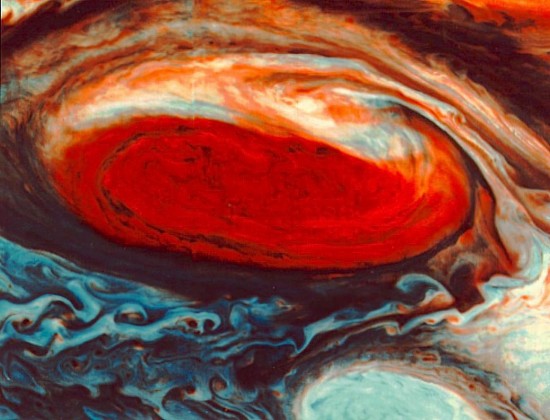
False color image of the Great Red Spot. Credit: Voyager 1/NASA Space Science Data Coordinated Archive
Mar 10, 2016
The Great Red Spot could be something different than what is expected.
As mentioned in a recent Picture of the Day, the Juno mission is slated to enter orbit around Jupiter in July of 2016. One of the mission’s primary targets is the Great Red Spot in Jupiter’s atmosphere. The Spot has persisted for as long as there have been telescopes to study it: more than 300 years. Astronomers think that it is a cyclonic storm driven by convective heat from below. However, exactly how it was formed and why it has persisted for so long remain a mystery.
The giant oval varies in size, from approximately 20,000 kilometers long to almost 40,000 kilometers, with a maximum width of around 21,000 kilometers. Earth looks small in comparison at 12,800 kilometers in diameter. Wind speeds around the perimeter of the Great Red Spot are measured at 635 kilometers per hour, twice as fast as a terrestrial tornado.
In March of 2010, the European Southern Observatory’s (ESO) Very Large Telescope detected variations in the temperature map of the spot. Observations revealed a warmer region at its center, corresponding to the deepest red color. Planetary scientists believe that the warmer areas in the center of the spot’s vortex are sufficient to drive its rotation. “Warm” is a relative term, since the Great Red Spot’s temperature averages -160 Celsius. The origin of its red color—from chemical changes in the atmosphere or upwelling of material from below—requires further study.
As Glenn Orton from the Jet Propulsion Laboratory wrote: “We once thought the Great Red Spot was a plain old oval without much structure, but these new results show that it is, in fact, extremely complicated.”
Astronomers are not sure why the gas giants each exhibit a unique overall color. Telescopes reveal that Neptune has a blue color, Uranus a green hue, Saturn a pale yellow aspect, and Jupiter a rusty red appearance.
Gas giant coloration and Jupiter’s enigmatic markings, especially the Great Red Spot, could have a different origin altogether. Rather than internally generated heat and convection, Jupiter’s turbulent atmosphere might be receiving its energy from an external source.
Previous Pictures of the Day note that gigantic “plasma tornadoes,” or flux tubes, enter Earth’s magnetosphere from space. They were found by the fleet of THEMIS satellites. The tubes are rotating at more than 1.5 million kilometers per hour and generating over 100,000 amps of electric charge flow. The flux tubes are electromagnetic fields forming twisted pairs of filaments. These filamentary formations are named after the one who originally discovered them, Kristian Birkeland. Birkeland currents follow magnetic field lines and draw charged material from their surroundings, electrodynamically sorting it with a force that can be orders of magnitude greater than gravity.
What ESO investigators could be witnessing is the influx of plasma filaments into Jupiter’s electrically charged environment. In an image of Jupiter, several bright points can be seen surrounding the Red Spot in an arc-shaped array. Below the spot is another bright arc-shape, indicative of increased infrared radiation emissions.
Birkeland currents rotate around each other, beginning as many strands. At first, there might be 56 filaments that merge into 28, then 14, and so on. As more charge flows through the circuit, the number of filaments reduces, but each pair becomes more energetic. Where Birkeland currents intersect, z-pinches occur as plasma density increases, releasing thermal (and other) radiation.
Rather than convection and warm gas, the Great Red Spot is probably rotating because of external electromagnetic fields. The Great Red Spot, as well as other vortices in Jupiter’s atmosphere, could be where Birkeland currents interact with the giant planet.
Stephen Smith












